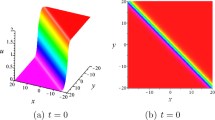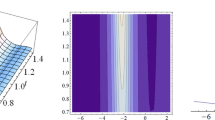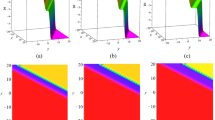Abstract
In this study, the generalized Hirota–Satsuma KdV systems with with some variable coefficients is used to simulate the interaction of three long waves in shallow water with different dispersion relations. Exact solutions of the equations under consideration are generated using a Lie symmetry transform and rapidly convergent approximation method. In terms of exponential functions, three new sets of exact solutions have been discovered. The solutions of the partial differential equations in question are then deduced by inverting them into the Lie symmetry transformation. A theorem has been put forth and proven to ensure that the first set of solutions obtained are bounded. The solutions are plotted using the results obtained from the theorems. The graphs show solutions that have different characteristics of multi-hump solutions. For different values of the arbitrary velocity function, the solution is shown to have M-shaped, S-shaped, L-shaped, snake-shaped, boomerang-shaped and boomerang-shaped with cyclic effects multi-hump soliton solutions. We find that by varying the variable coefficient, we can tune the structure of the above solitons. These results demonstrate not only the efficiency of the updated method, but also that the solution has been enhanced with new multi-hump features.










Similar content being viewed by others
Data availability
Data sharing not applicable—no new data generated
References
Ablowitz, M.J., Segur, H.: Solitons and the Inverse Scattering Transform. SIAM, Philadelphia (1981)
Adomian, G.: Solving Frontier Problems of Physics: The Decomposition Method. Kluwer Academic Publishers, Boston (1994)
Adomian, G., Rach, R.: Inversion of nonlinear stochastic operators. J. Math. Anal. Appl. 91(1), 39–46 (1983)
Adomian, G., Rach, R.: Analytic solution of nonlinear boundary-value problems in several dimensions by decomposition. J. Math. Anal. Appl. 174(1), 118–137 (1993)
Adomian, G., Rach, R.: A new algorithm for matching boundary conditions in decomposition solutions. Appl. Math. Comput. 57(1), 61–68 (1993)
Adomian, G., Rach, R.: Modified decomposition solution of linear and nonlinear boundary-value problems. Nonlinear Anal. Theory Methods Appl. 23(5), 615–619 (1994)
Alquran, M., Al-Khaled, K., Ali, M., Arqub, O.A.: Bifurcations of the time-fractional generalized coupled Hirota–Satsuma KdV system. Waves Wavelets Fractals 3(1), 31–39 (2017)
Apostol, T.M.: Mathematical Analysis. 2nd Edition, Addison-Wesley, Boston (1974)
Baumann, G.: Symmetry Analysis of Differential Equations with Mathematica®. Springer, New York (2000)
Bhandari, N.: Generating functions involving binomial coefficients (4n 2n), it’s squared, reciprocal and their closed forms for hypergeometric expressions, romanian mathematical magazine. an interactive journal. Romanian Mathematical Magazine, An interactive journal (2021)
Buffoni, B., Séré, E.: A global condition for quasi-random behavior in a class of conservative systems. Commun. Pure Appl. Math. 49(3), 285–305 (1996)
Cao, Y.H., Wang, D.S.: Prolongation structures of a generalized coupled Korteweg–de Vries equation and Miura transformation. Commun. Nonlinear Sci. Numer. Simul. 15(9), 2344–2349 (2010)
Cattani, F., Kim, A., Hansson, T., Anderson, D., Lisak, M.: Multihump soliton-like structures in interactions of lasers and Bose–Einstein condensates. EPL (Europhys. Lett.) 94(5), 53003 (2011)
Das, P.K.: Rapidly convergent approximation method to chiral nonlinear Schrodinger’s equation in (1+2)-dimensions. Sohag J. Math. 5, 29–33 (2018)
Das, P.K.: The rapidly convergent approximation method to solve system of equations and its application to the Biswas–Arshed equation. Optik 195, 163134 (2019)
Das, P.K.: Chirped and chirp-free optical exact solutions of the Biswas–Arshed equation with full nonlinearity by the rapidly convergent approximation method. Optik 223, 165293 (2020)
Das, P.K.: New multi-hump exact solitons of a coupled Korteweg–de-Vries system with conformable derivative describing shallow water waves via RCAM. Phys. Scr. 95(10), 105212 (2020)
Das, P.K., Mandal, S., Panja, M.M.: Piecewise smooth localized solutions of Liénard-type equations with application to NLSE. Math. Methods Appl. Sci. 41(17), 7869–7887 (2018)
Das, P.K., Panja, M.M.: An Improved Adomian Decomposition Method for Nonlinear ODEs. In: Sarkar, S., Basu, U., De, S. (eds) Applied Mathematics. Springer Proceedings in Mathematics & Statistics, vol 146. Springer, New Delhi. (2015). https://doi.org/10.1007/978-81-322-2547-8_18
Das, P.K., Panja, M.: A rapidly convergent approximation method for nonlinear ordinary differential equations. IJSEAS 2(8), 334–348 (2016)
Das, P.K., Singh, D., Panja, M.: Solutions and conserved quantities of Biswas–Milovic equation by using the rapidly convergent approximation method. Optik 174, 433–446 (2018)
Das, P.K., Singh, D., Panja, M.M.: Some modifications on RCAM for getting accurate closed-form approximate solutions of Duffing-and Lienard-type equations. J. Adv. Math. 16, 8213–8225 (2019)
Duan, J.S., Rach, R.: A new modification of the adomian decomposition method for solving boundary value problems for higher order nonlinear differential equations. Appl. Math. Comput. 218(8), 4090–4118 (2011)
Durur, H.: Different types analytic solutions of the (1+ 1)-dimensional resonant nonlinear schrödinger’s equation using (g’/g)-expansion method. Mod. Phys. Lett. B 34(03), 2050036 (2020)
Geng, X., Ren, H., He, G.: Darboux transformation for a generalized Hirota–Satsuma coupled Korteweg–de Vries equation. Phys. Rev. E 79(5), 056602 (2009)
Goemans, M.: 18.310 lecture notes: Generating functions, MIT Mathematics (2015) https://math.mit.edu/~goemans/18310S15/generating-function-notes.pdf. http://math.mit.edu/~goemans/18310S15/18310.html
Gorshkov, K., Ostrovsky, L., Papko, V., Pikovsky, A.: On the existence of stationary multisolitons. Phys. Lett. A 74(3–4), 177–179 (1979)
Groves, M.: Solitary-wave solutions to a class of fifth-order model equations. Nonlinearity 11(2), 341 (1998)
Hirota, R., Satsuma, J.: Soliton solutions of a coupled Korteweg–de Vries equation. Phys. Lett. A 85(8–9), 407–408 (1981)
Hosseini, K., Manafian, J., Samadani, F., Foroutan, M., Mirzazadeh, M., Zhou, Q.: Resonant optical solitons with perturbation terms and fractional temporal evolution using improved tan (\(\phi \) (\(\eta \))/2)-expansion method and exp function approach. Optik 158, 933–939 (2018)
Hu, H.C., Liu, Q.: New darboux transformation for Hirota–Satsuma coupled KdV system. Chaos Solitons Fractals 17(5), 921–928 (2003)
Khalique, C.M.: Closed-form solutions and conservation laws of a generalized Hirota–Satsuma coupled kdv system of fluid mechanics. Open Phys. 19(1), 18–25 (2021)
Kumar, V.S., Rezazadeh, H., Eslami, M., Izadi, F., Osman, M.: Jacobi elliptic function expansion method for solving kdv equation with conformable derivative and dual-power law nonlinearity. Int. J. Appl. Comput. Math. 5(5), 127 (2019)
Li, Z., Zhao, Z.: Blow-up criteria and periodic peakons for a two-component extension of \(\mu \)-version modified Camassa–Holm equation. Commun. Theor. Phys. 72, 035004 (2020). https://doi.org/10.1088/1572-9494/ab690b
Ostrovskaya, E.A., Kivshar, Y.S., Skryabin, D.V., Firth, W.J.: Stability of multihump optical solitons. Phys. Rev. Lett. 83(2), 296 (1999)
Ostrovskaya, E.A., Mingaleev, S.F., Kivshar, Y.S., Gaididei, Y.B., Christiansen, P.L.: Multi-soliton energy transport in anharmonic lattices. Phys. Lett. A 282(3), 157–162 (2001)
Parra Prado, H., Cisneros-Ake, L.A.: Multi-hump bright and dark solitons for the Schrödinger–Korteweg–de Vries coupled system. Chaos Interdiscip. J. Nonlinear Sci. 29(5), 053133 (2019)
Qi, F., Ward, M.D.: Closed-form formulas and properties of coefficients in Maclaurin’s series expansion of Wilf’s function composited by inverse tangent, square root, and exponential functions. arXiv e-prints pp. arXiv:2110.08576 (2021)
Rosen, K.H.: Discrete Mathematics & Applications. McGraw-Hill, New York (1999)
Rydén, C.: Generating functions: powerful tools for recurrence relations. Hermite polynomials generating function (2023)
Singh, K., Gupta, R.: Lie symmetries and exact solutions of a new generalized Hirota–Satsuma coupled KdV system with variable coefficients. Int. J. Eng. Sci. 44(3–4), 241–255 (2006)
Tian, B., Gao, Y.T.: Truncated painlevé expansion and a wide-ranging type of generalized variable-coefficient Kadomtsev–Petviashvili equations. Phys. Lett. A 209(5–6), 297–304 (1995)
Vithya, A., Rajan, M.M., Prakash, S.A.: Combined effects of frequency and higher-order effects on soliton conversion in an erbium fiber with inhomogeneous broadening. Nonlinear Dyn. 91(1), 687–696 (2018)
Wang, L., Li, S., Qi, F.H.: Breather-to-soliton and rogue wave-to-soliton transitions in a resonant erbium-doped fiber system with higher-order effects. Nonlinear Dyn. 85(1), 389–398 (2016)
Wilf, H.S.: Generatingfunctionology. CRC Press, Boca Raton (2005)
Wu, Y., Geng, X., Hu, X., Zhu, S.: A generalized Hirota–Satsuma coupled Korteweg–de Vries equation and Miura transformations. Phys. Lett. A 255(4–6), 259–264 (1999)
Xue, L., Liu, Q., Wang, D.: A generalized Hirota–Satsuma coupled kdv system: darboux transformations and reductions. J. Math. Phys. 57(8), 083506 (2016)
Yomba, E., Zakeri, G.A.: Dynamics of wide and snake-like pulses in coupled schrödinger equations with full-modulated nonlinearities. Phys. Lett. A 380(4), 530–539 (2016)
Zayed, E.E., Abourabia, A., Gepreel, K.A., Horbaty, M.E.: On the rational solitary wave solutions for the nonlinear Hirota–Satsuma coupled kdv system. Appl. Anal. 85(6–7), 751–768 (2006)
Zhao, L., Li, P., Han, T.: Bifurcation, traveling wave solutions, and stability analysis of the fractional generalized Hirota–Satsuma coupled kdv equations. Discrete Dyn. Nat. Soc. 2021, 1–6 (2021)
Zhao, Z., Han, B.: Lie symmetry analysis, bäcklund transformations, and exact solutions of a (2+1)-dimensional Boiti–Leon–Pempinelli system. J. Math. Phys. 58(10), 101514 (2017)
Zhao, Z., He, L.: Lie symmetry, nonlocal symmetry analysis, and interaction of solutions of a (2+1)-dimensional kdv–mkdv equation. Theor. Math. Phys. 206(2), 142–162 (2021)
Zigao, C., Junfen, L., Fang, L.: New exact solutions for the variable-coefficient generalized Hirota–Satsuma coupled kdv system. In: 2010 international conference on electrical and control engineering, pp. 1349–1354. IEEE (2010)
Acknowledgements
The author appreciates the referees’ comments, which helped to improve the manuscript. The author acknowledges Professor Madan Mohan Panja of the mathematics department of Visva-Bharati for his helpful advice in revising the article.
Author information
Authors and Affiliations
Corresponding author
Ethics declarations
Conflict of interest
The author declares that he has no conflict of interest.
Additional information
Publisher's Note
Springer Nature remains neutral with regard to jurisdictional claims in published maps and institutional affiliations.
Rights and permissions
Springer Nature or its licensor (e.g. a society or other partner) holds exclusive rights to this article under a publishing agreement with the author(s) or other rightsholder(s); author self-archiving of the accepted manuscript version of this article is solely governed by the terms of such publishing agreement and applicable law.
About this article
Cite this article
Das, P.K. The interaction of three long shallow-water waves with different dispersion relations modeled by generalized Hirota–Satsuma KdV systems with some variable coefficients. Nonlinear Dyn 111, 21259–21278 (2023). https://doi.org/10.1007/s11071-023-08929-2
Received:
Accepted:
Published:
Issue Date:
DOI: https://doi.org/10.1007/s11071-023-08929-2




